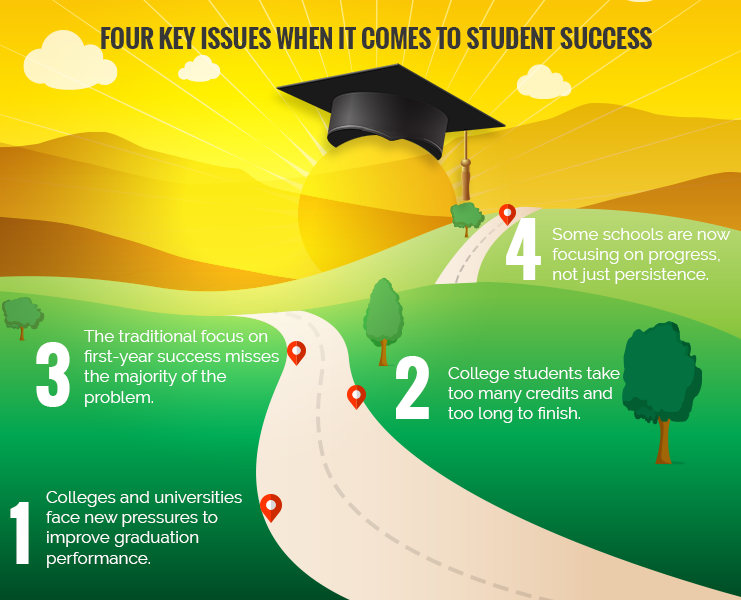Are Guided Pathways The Key to Graduation?
When students enter their post-secondary journeys, they begin with the end in mind: graduation. They apply, enroll and begin their experience in the hopes that in two, four, or six years, they will graduate their program of study and move into the workforce prepared. They understand there are logical steps to get them from point A to point B, but few students set out with a detailed plan on how to navigate that journey.
Even though the expense of higher learning can be one of the largest investments in one’s lifetime, it’s rather amazing to see how ill-prepared students can be. If you were to plan a trip abroad, for instance, you would likely have a plan for every day of your trip. You would know the time and dates of your flights. You would have completed all of the necessary tasks to get your passport and currency exchange. You would have booked rooms at hotels, purchased tickets for museums, planned an itinerary for all of the sightseeing, and even researched the best restaurants along the way.
All of this planning is for a trip that may last a week or two and cost a few thousand dollars. Why isn’t the same care given to the much larger investment of time, money and energy in college? Much of the reason isn’t laziness or apathy; it’s twofold – students believe they will “figure it out along the way,” and that the institution they will be attending will help them.
This perspective isn’t always wrong, it’s just naive. Many schools lack the appropriate guidance capability or resources to hold every student’s hand along their higher learning journeys. They offer advisors to a limited degree, but there isn’t much structure or intentional processes in place to establish guided pathways for each student, particularly beyond their first year. The institution can offer support, but it’s generally student-initiated after the first year and can come too late.
“While students certainly make choices about enrollment based on personal circumstances, the many course and program options and the limited guidance currently provided by community colleges likely contribute to students’ meandering and varied pathways through college.” – Community College Research Center
More Structure and Support with Fewer Options
While the Community College Research Center is focused on community colleges, even four-year universities are taking notice of the problem. Both are adopting the guided pathway approach which provides a much more structured, relevant program for each student. These guided pathways promise to support the students whether the students seek out that help or not. It requires the different departments within the institution to work collaboratively and communicate more frequently so that students never “meander” but are highly focused on goals that set them up for on-time graduation.
Related: Guided Pathways Are Better Than Going at It Alone
Research backs up the claim that when students are given fewer options and more support, they do better. Here are a few findings:
- Having too many choices leads to indecision, procrastination, self-doubt, and decision paralysis.
- People handle complex decisions better if they are helped to think through options hierarchically, in manageable sets.
- Reminders, assistance and feedback can increase desired behaviors.
- Academic plans with defaults help students make course choices that will move them towards their goals, while still permitting them to customize their schedules.
- Monitoring student progress and giving them frequent feedback about next steps helps students make choices.
- Students benefit when they have clear learning goals and a concrete sense of how they are progressing towards those goals.
- Providing students with a big-picture overview and how courses fit together improves learning.
By implementing a guided pathway structure, one large university was able to:
- Improve year-to-year retention rates from 86% to 92%
- Improve four-year graduation rates from 44% to 61%
- Reduce students graduating with excess credits from 30% to only 5%
Students Need Help
The Advisory Board Company, a research and consulting organization including 800 member colleges and universities, identified four key issues when it comes to student success:
- Colleges and universities face new pressures to improve graduation performance.
- College students take too many credits and too long to finish.
- The traditional focus on first-year success misses the majority of the problem.
- Some schools are now focusing on progress, not just persistence.

The strategies they note to guide progress:
- Maximize credit attempts
- Reduce lost credits
- Simplify course selection
- Preserve flexibility
The report also cites research showing the average student completes an unnecessary extra semester worth of courses, often due to issues stemming from a lack of sufficient advisement. These are credits students are paying for that do not contribute to their program of study, only to their student debt.
Give Students What They Need, When They Need It
Students need to be given the tools and technology that set them up to succeed from the beginning of their journey until they graduate. This includes the ability to map out their goals based on their program of study with realistic timeframes, costs and schedules. Like a detailed travel plan, no student should ever wonder what’s next.
Whether the student is young or old, full-time or part-time, they deserve to go into school with a clear understanding of their “trip.” There should be no confusion about exactly how many hours they need to take each semester, which courses are eligible for both their degree requirements and their financial aid, the order in which they should enroll in those courses, and how any deviation from their plan will impact their goals and their budget.
They should be able to easily build their schedules and monitor their progress, ideally via a degree map they can view on their mobile device. If students can access their specific road map on the device they carry with them and use multiple times a day, they are more likely to stay on top of their own journey. Asking them to schedule appointments with advisors to get anything accomplished only leads to the procrastination mentioned above. Mobile apps serve as their GPS, directing them step by step to their end destination.
Is Automation The Answer?
The cost of not implementing this type of technology is significant. The Advisory Board Committee found that the estimated cost of adding the number of advisors that would be required to support students in a similar way would cost anywhere from $0.5M for a small institution to nearly $2M for a large institution. How can institutions provide the level of structure and support students need without breaking the budget?
The more automation schools can bring to their processes, the more students can be helped with fewer required resources.
Higher learning institutions are in a tough spot, negotiating the pressure from the Department of Education, the desire to help students succeed and often limited resources. Institutions may find technology is a life raft. If they can strike a balance between technology and academics, they will be better positioned to offer students the academic support they need via programs and channels students now require.




